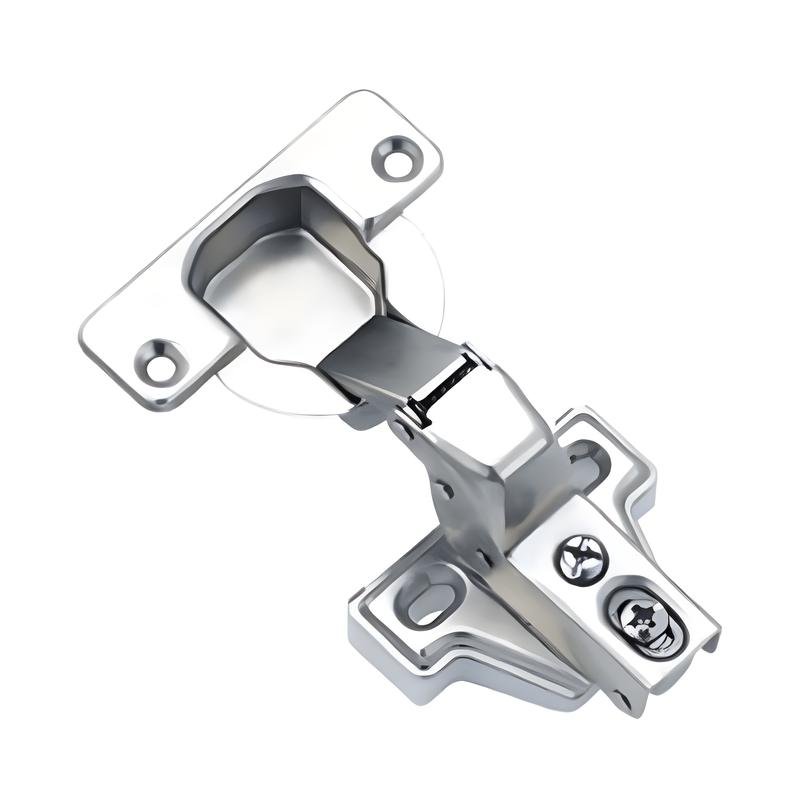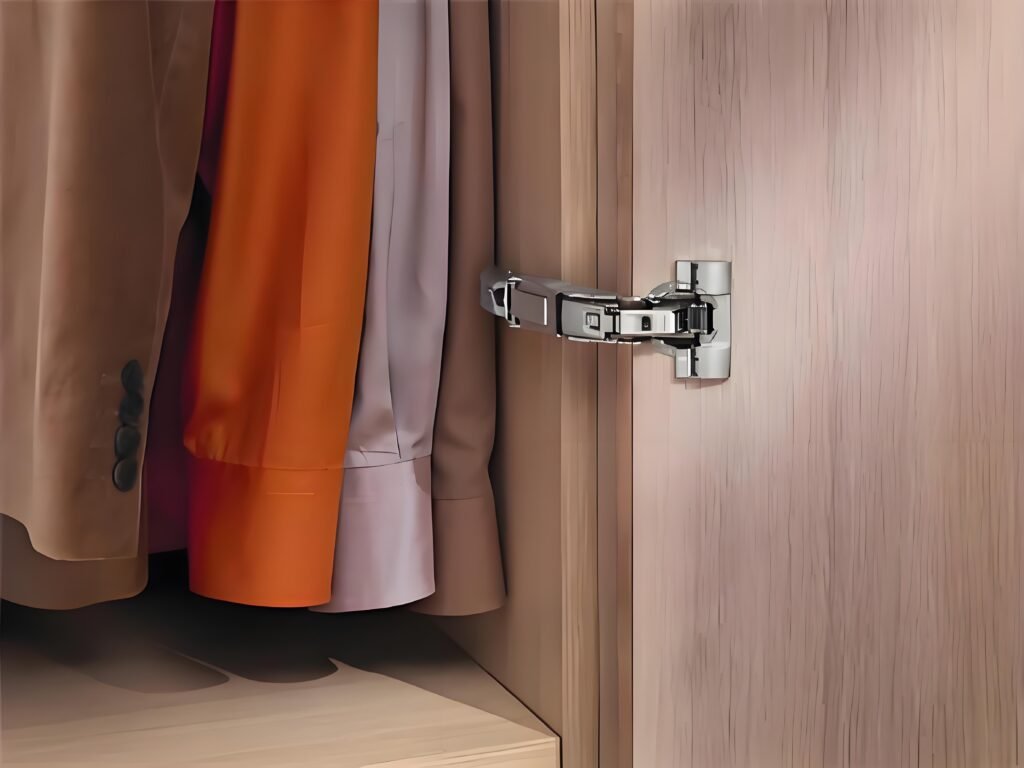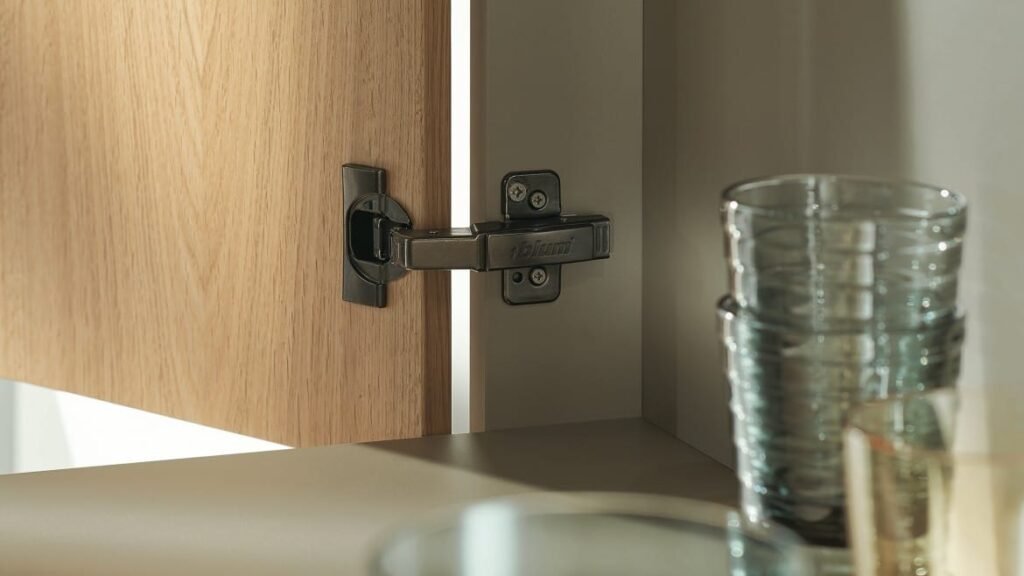
ø40 Fixed Short Arm Concealed Door Hinges - TF207
Inset(C=1/4)
Main Material: Cold-rolled steel/Q235
Finish: Nickel Plated
Opening hinge: 95°
Dia. of hinge cup: 40mm
Depth of hinge cup: 11.3mm
Product thickness: 1.0mm
Door (K) dimension: 3-12mm
Door thickness: 14-22mm
Optional rapid regulation.
Application Segment
Cabinet Doors, Wardrobe Doors


Our Services

MOQ Offered
We provide flexible minimum order quantities, allowing you to start small and scale up as needed.

Large Inventory
Ensuring Ample Stock for Immediate Shipment, Eliminating Wait Times for Production.

Complete Specifications
We refine various specifications of hinges according to different usage scenarios.
AOLISHENG manufactures concealed door hinges that meet standards, offering customized services and solutions to help your business succeed.
Why Choose AOLISHENG
Rich Experience
With years of concealed door hinges production experience, we have a team of professionals specializing in hinge design, manufacturing, and management.
Leading Production Capacity
We possess CNC machining for heavy-duty applications, wire-cutting machines, automated balancing, pressing equipment, and electroplating production lines for hinge manufacturing.
Quality Assurance
All hinges undergo over 48 hours of salt spray testing and are subjected to more than 80,000 cycles of open-close testing with appropriate door weights, meeting the quality standards of QB/T2189-1995.
Mass Production Capability
With over 10,000 square meters of production facilities and thousands of square meters dedicated to electroplating workshops, we ensure a large-scale supply of hinges.
We Look Forward To Your Contact
AOLISHENG is your trusted global partner for high-quality drawer slide and hinges production, with strategic factories worldwide and professional local service teams. Partnering with AOLISHENG ensures efficient project delivery, robust supply chains, expert technical support, and a thriving customer base.
FAQ
What are the three kinds of concealed hinges?
There are three main types of concealed door hinges:
1. Invisible hinges (also called “hidden hinges”):
Features: These hinges are completely hidden in the door frame when the door is closed, with no protruding parts in appearance. They provide a seamless visual effect, making the door almost integrated with the wall.
Application: Suitable for doors that require high concealment and a neat appearance.
2. Adjustable concealed door hinges:
Features: In addition to being hidden, these concealed door hinges also have an adjustment function that can adjust the opening and closing gap and position of the door to ensure perfect alignment and smooth opening and closing of the door.
Application: Suitable for door installations that require precise adjustment and high flexibility.
3. Heavy-duty concealed door hinges:
Features: These concealed door hinges are designed to withstand heavier doors are usually made of strong materials and have enhanced load-bearing capacity. Although they are also hidden in the door frame, their structure is more stable.
Application: Suitable for heavier invisible doors or occasions where additional load-bearing support is required.
What is the difference between concealed hinge and invisible hinge?
Although there are differences in the names of concealed door hinges and invisible hinges, they generally refer to the same or similar types of hinges used to conceal the opening and closing mechanism of the door. The following is a detailed explanation of the differences and characteristics between them:
Concealed door hinges
1. Definition:
Concealed door hinges refer to a situation in which when the door is closed, all parts of the concealed door hinges are hidden in the door frame and the wall, and the exposed part of the concealed door hinges cannot be seen. This can maintain the flatness and beauty between the door and the wall.
2. Features:
Design: The design of the concealed door hinges makes the door body almost completely fit the wall when closed, and no protruding parts can be seen.
Function: In addition to being beautiful, concealed door hinges usually enable the door to open and close smoothly, and some high-end concealed door hinges also have an adjustment function that can adjust the opening and closing gap of the door.
Application: Suitable for occasions that require a neat appearance and high concealment, such as high-end residential and commercial spaces.
Invisible Hinge
1. Definition:
Invisible hinges are similar to invisible door hinges and usually refer to invisible door hinges that are completely hidden between the door and the door frame. The difference in name is mainly due to language or brand differences, but the function and design concept are similar.
2. Features:
Design: Invisible hinges usually also have a seamless visual effect, and no part of the hinge is exposed when the door is closed.
Function: The design and function of this hinge are similar to invisible hinges, both of which are committed to providing a beautiful and neat appearance and keeping the door open and closed smoothly.
Application: It is also suitable for occasions that require concealment and beauty. The specific application may be the same as invisible hinges.
Summary
In general, concealed door hinges and invisible hinges are very similar in function and design, and the main difference is the difference in name. Both are designed to provide a hidden visual effect so that the connection between the door and the wall does not reveal the existence of the hinge. Which hinge to choose is more based on brand, design requirements, and specific installation needs.
How to turn a regular door into a hidden door?
The process of converting a regular door into a hidden door involves several key steps. Here is a detailed guide:
1. Choose the right concealed door hinges
Type: Choose a concealed door hinge that is suitable for the weight and thickness of the door. Common types include concealed door hinges and seamless hinges.
Quantity: Depending on the size and weight of the door, two or more concealed door hinges are usually required.
2. Prepare the door frame and door panel
Measurement: Accurately measure the dimensions of the door frame and door panel to ensure that the door can be perfectly docked on the wall.
Finish the door panel: If the door panel needs to be adjusted in thickness or edges, use sandpaper or power tools to trim it to make it suitable for the new concealed door hinges and hidden door design.
3. Install the concealed door hinges
Mark the position: Mark the position of the concealed door hinges on the door frame and door panel. Make sure the installation position of the concealed door hinge is symmetrical and level.
Cut the groove: Cut the groove according to the size of the concealed door hinges on the door frame and door panel so that the concealed door hinges can be fully embedded. Be careful when cutting and ensure that the depth and width of the groove are accurate.
Fix the concealed door hinges: Install the concealed door hinges into the cut groove and fix it with screws to ensure that the concealed door hinges are firmly installed on the door frame and door panel.
4. Install the door
Align the door: Align the door with the door frame to ensure that the joints of the concealed door hinges are perfectly aligned. Check whether the door opens and closes smoothly.
Adjust the door gap: Use the adjustment function on the concealed door hinges to ensure that the gap between the door and the wall is uniform and the door can fit the wall completely.
5. Deal with the appearance of the door
Paint or wallpaper: To make the door fully integrated into the wall, it is usually necessary to paint the door panel or paste the same wallpaper or decorative materials as the wall to make the appearance of the door seamlessly connected with the wall.
6. Check and adjust
Test the door: Open and close the door several times to check the stability of the invisible door and the function of the hinge. If any problems are found, make corresponding adjustments or corrections.
With these steps, you can transform an ordinary door into an invisible door and achieve a perfect integration with the wall. If you encounter difficulties in the process, it is recommended to consult a professional door and window installer.
What is the difference between exposed and concealed hinges?
Exposed hinges and concealed door hinges differ mainly in appearance and installation methods. Here are the detailed differences:
Exposed hinges
1. Appearance:
Features: All parts of the hinge are exposed outside the door and door frame and are visible. Usually traditional hinges with simple designs.
Style: Although there are some decorative exposed hinges in modern designs, their overall appearance is more obvious and traditional.
2. Installation:
Method: When installed, the blades and fixed parts of the hinge are exposed and fixed directly to the door frame and door.
Application: Suitable for installation of any standard door, the installation process is relatively simple.
3. Maintenance:
Advantages: Repair and replacement are relatively easy because the hinge part is completely exposed and easy to operate.
Disadvantages: Exposed hinges may affect the overall beauty, especially in high-end decoration.
Concealed Door Hinges
1. Appearance:
Features: Concealed door hinges are completely hidden inside the door and door frame, and no part of the concealed door hinges can be seen when the door is closed. Clean and modern appearance.
Style: Suitable for spaces that pursue seamless visual effects and high-end decoration styles.
2. Installation:
Method: Concealed door hinges are embedded in the internal grooves of the door and door frame, and the concealed door hinges are completely hidden when the door is closed.
Application: Requires precise installation and adjustment, usually requires a professional operation.
3. Maintenance:
Advantages: Provides a more modern and neat appearance, and the door body is almost flush with the wall.
Disadvantages: Repair and replacement may be more complicated because the concealed door hinges are hidden inside and the door frame or door panel must be removed to operate.
Summary
Exposed hinges are more suitable for occasions that require simple installation and repair, but may appear traditional in appearance. Concealed door hinges provide a modern and neat visual effect, but are more complicated to install and maintain. Which hinge to choose depends on specific needs and decoration style.
What are the disadvantages of a concealed door closer?
The main disadvantages of concealed door closers include the following:
1. Installation complexity
Professional requirements: Concealed door closers usually require complex cutting and installation on the door frame and door, and may require professional installation.
Alignment difficulty: Precise alignment is required during installation to ensure the normal opening and closing function of the door, which may increase the difficulty and cost of installation.
2. Maintenance and adjustment
Difficult to access: Since the closer is hidden in the door frame, maintenance, and adjustment may be more difficult, especially when repairs or replacements are required.
Adjustment restrictions: Although many concealed door closers provide adjustment functions, the adjustment operation is usually not as convenient as that of exposed door closers.
3. Cost
Higher cost: Concealed door closers are generally more expensive than exposed door closers, especially high-quality and high-performance models.
Long-term expenses: Due to the complexity of installation and maintenance, additional long-term expenses may be incurred.
4. Reliability issues
Confined space: Hidden installation locations may be subject to space restrictions or design restrictions that affect the normal function of the closer.
Durability: Some concealed door closers may face durability issues in long-term use, especially in high-frequency use environments.
5. Design limitations
Design compatibility: Concealed door closers may not be suitable for all types of doors or door frame designs, especially specially designed doors.
Summary
The main disadvantages of concealed door closers include installation complexity, maintenance and adjustment difficulties, higher costs, potential reliability issues, and design compatibility limitations. These factors need to be considered when selecting and weighing against the aesthetic and functional advantages they bring.
How thick should door glass be?
The thickness of door glass depends on the type, purpose, and design requirements of the door. Here are several common types of door glass and their recommended thickness ranges:
1. Standard interior door glass
Recommended thickness: 5mm (1/4 inch) to 6mm (1/4 to 1/2 inch).
Use: Suitable for ordinary interior doors, such as partitions in offices or bedrooms.
2. Exterior door glass
Recommended thickness: 8mm (5/16 inch) to 10mm (3/8 inch).
Use: For exterior doors, such as front doors or back doors, which require higher strength and security to withstand the external environment and frequency of use.
3. Tempered glass door
Recommended thickness: 10mm (3/8 inch) to 12mm (1/2 inch).
Use: Suitable for doors that require high strength and security, such as bathroom doors, doors in commercial buildings, or doors in high-traffic areas.
4. Laminated glass door
Recommended thickness: 12mm (1/2 inch) to 16mm (5/8 inch).
Application: Laminated glass has higher security and sound insulation, suitable for doors with high-security requirements, such as bank doors or safety glass partitions.
5. Double glass door (insulating glass)
Recommended thickness: 20mm (3/4 inch) or more.
Application: Double or triple glass doors are used to improve insulation and energy saving, suitable for exterior doors that require high energy efficiency.
6. Glass shower door
Recommended thickness: 8mm (5/16 inch) to 10mm (3/8 inch).
Application: Used for a shower room or bathtub enclosure, which requires sufficient strength to withstand the humid environment and daily use.
Summary
The thickness of door glass ranges from 5mm (1/4 inch) to 16mm (5/8 inch), and the specific choice depends on the purpose and requirements of the door. Tempered glass and laminated glass provide higher security, while double glass focuses on energy efficiency and insulation. Choosing the right thickness can ensure the strength, durability, and functionality of the door.
Is a glass door safe for a home?
Glass doors can be safe in homes, but to ensure their safety, there are several key factors to consider:
1. Use high-strength glass
Tempered glass: Tempered glass is specially treated to be stronger than ordinary glass and can withstand greater impact. When broken, tempered glass will break into small pieces, reducing the risk of injury.
Laminated glass: Laminated glass consists of two or more layers of glass and a plastic layer in the middle, which can maintain the overall structure even if it breaks, providing additional safety.
2. Install suitable hinges and fixtures
High-quality hinges: Use high-strength hinges to support glass doors to ensure the stability and safety of the door.
Fixtures: Make sure the glass door’s fixtures (such as clamps and adhesives) can firmly fix the glass to the door frame to prevent the door from shifting or loosening.
3. Edge treatment
Smooth edges: Make sure the edges of the glass door are polished to avoid sharp edges that may cause injuries.
Protective film: For edges that are easily touched, protective films or protective strips can be used for added safety.
4. Security locks
Anti-theft design: Choose the right locks and door handles to ensure that the door cannot be easily opened without authorization.
Lock quality: High-quality locks and door handles can provide additional security protection.
5. Proper door frame design
Solid frame: Make sure the door frame can provide sufficient support and fit well with the glass door to prevent deformation or instability of the door.
Sealing strips: Use sealing strips to reduce the gap between the door and the door frame, and enhance the sealing and security of the door.
6. Regular maintenance
Inspection and maintenance: Regularly check the condition of the glass door, including hinges, locks, and fixtures, to ensure that they are in good working condition.
Cleaning and maintenance: Keep the glass door clean and well-maintained to prevent damage to the glass or hinges.
7. Protective measures
Alarm system: Install an access control system or alarm system to increase security.
Anti-collision strips: For glass doors, installing anti-collision strips can reduce damage caused by collisions or accidents.
Summary
Glass doors can be safe in homes, but you need to ensure the use of high-strength glass, installation of suitable hinges and fixings, good edge treatment, secure locks and door frame design, and regular maintenance. By taking these measures, you can effectively improve the safety and durability of glass doors.
